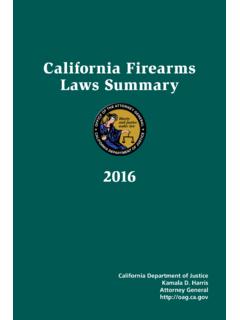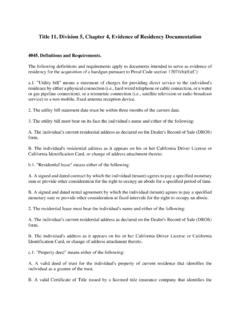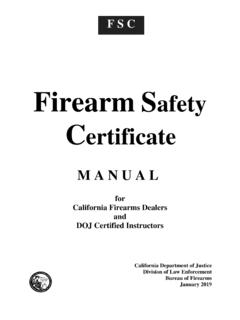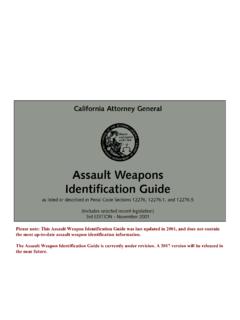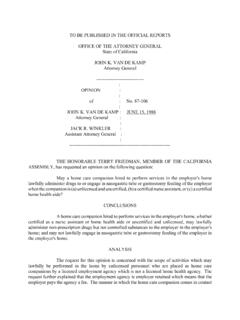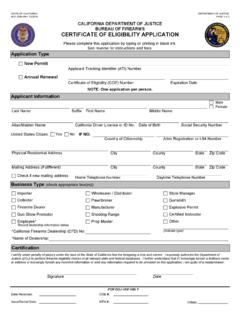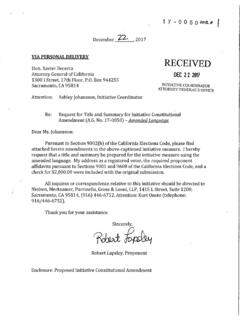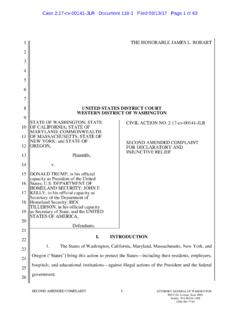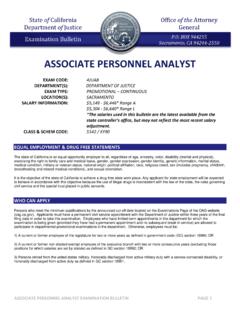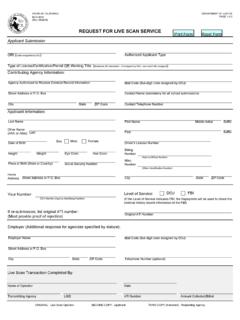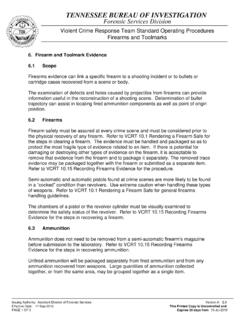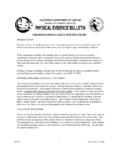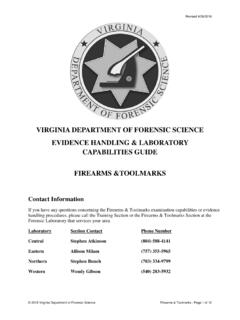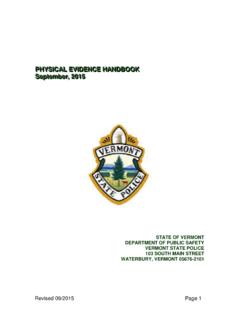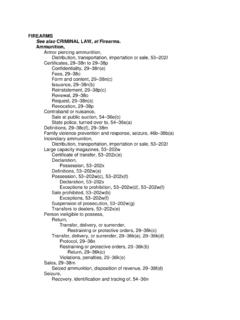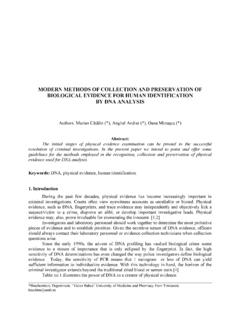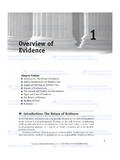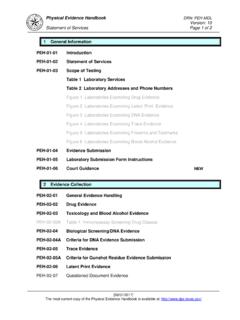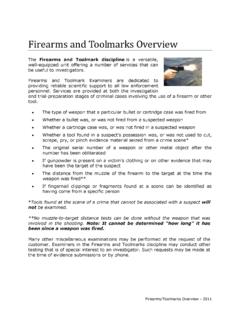Transcription of Physical Evidence Bulletin - Office of the Attorney General
1 Bureau of Forensic Services California Department of Justice Physical Evidence Bulletin Firearms Evidence collection procedures Purpose The Physical Evidence Bulletin (PEB) is a guideline intended for law enforcement agencies to follow when submitting Evidence to Bureau of Forensic Services (BFS) Laboratories. Physical Evidence Bulletins are not intended to be used in lieu of training in the collection of Evidence . Analysis and results that may be obtained The Bureau of Forensic Services provides analytical support to law enforcement agencies through the examination of firearms Evidence . Firearms and related Evidence are encountered in crimes against persons such as homicide, assault, rape, and robbery; and in other crimes such as burglary and narcotics violations.
2 While comparisons of bullets and cartridge cases to test fired components from specific firearms are the most common examinations requested, other examinations may include: shooting distance determinations, examination of firearms for functioning or modification, determination of possible firearms used, serial number restoration, and assault weapon determination. Evidence that an individual was in the proximity of a firearm when it was discharged or has recently handled a firearm may be determined through the analysis of gunshot residue (GSR) collected from a person s hands or other body surfaces (see PEB 15). Evidence of who handled a firearm may be developed from latent fingerprints or trace (touch) DNA recovered from the firearm (see PEB 4).
3 Handling and safety of firearms The location and condition of firearms and related Evidence at a crime scene should be documented through diagrams and photographs before recovering and securing. Close-up photos of the firearm should document the condition and position of visible features such as the safety, action ( bolt, slide, etc.), and hammer. Although Physical Evidence is important, safety must be the first consideration. Each situation should be evaluated before deciding to unload an Evidence firearm . Caution: treat a firearm at all times as if it is loaded. If the weapon is a type that can be safely transported in a loaded condition, this is acceptable; however, depending on the circumstances it may be unnecessary or unwise to transport a loaded firearm .
4 In such a case, the firearm should be unloaded, with care taken to preserve all types of possible BFS 23 Page 1 of 6 PEB 12 (Rev. 2/10/2014) Evidence . This Evidence includes fingerprints, visible blood, hairs, fibers, cylinder halos, debris in the barrel(s) and chamber(s), and touch DNA. The weapon should be handled on those areas least likely to retain latent fingerprints such as knurled or checkered areas, while wearing fresh gloves to prevent contamination of any surfaces with material that may contain DNA. UNLOADING: Before unloading or securing any firearm as Evidence , record the position, as found, of any safety, cocking indicator [including a visible or partially hidden hammer], loaded-chamber indicator, selector, or other control feature.
5 Instructions for unloading the most common firearms follow but will not apply to all firearms which may be encountered. Unloading Revolvers: Prior to moving the cylinder, it should be marked to indicate its position as found. This can be done with short pen or scribe marks on the cylinder, along each side of the frame top strap. The position of each cartridge/case in the cylinder should be recorded in field notes as diagramed below. When opening the revolver to document and remove the cartridges/cases, keep the revolver pointed in a safe, downward direction to keep the cartridges/cases from falling out. All cartridges/cases removed should be packaged separately and handled so as to preserve possible fingerprints, DNA, and trace Evidence .
6 The position of each cartridge/case in the cylinder, and any other pertinent information, should be recorded in the field notes. DO NOT mark the actual cartridges/cases. FACING REAR OF CYLINDER EXAMPLE NOTES Chamber Position Condition Cartridge Headstamps 1 2 3 4 5 6 Fired Fired Fired Fired Unfired Unfired WINCHESTER 357 MAG 357 MAGNUM R -P 38 SPL W-W 38 SPECIAL FEDERAL 357 MAGNUM WINCHESTER 38 SPL+P BFS 23 Page 2 of 6 PEB 12 (Rev. 2/10/2014) Unloading Single Shot, Repeating, and Auto Loading (Semi-Automatic) Firearms: Keep the firearm pointed in a safe direction at all times. If it is a semi-auto or repeating firearm (such as a bolt, slide, or lever action), remove the magazine if it can be detached.
7 Do not remove cartridges from a detachable magazine, or mark the cartridges/cases directly. Clear the chamber by slowly drawing back the slide/bolt handle or opening the action. Examine the chamber visually to ensure that no cartridge is in the chamber. If there is a cartridge present, it should be removed and packaged separately. If the firearm has a non-detachable internal magazine, carefully remove the cartridges making note of the order in which they were removed from the magazine. If possible, leave the action open or block it open with a non-marring, DNA free item. Separately package the firearm , any detachable magazine, and any extracted cartridges or cartridge cases. Take care to preserve any possible fingerprints, trace Evidence , or DNA Evidence .
8 Contact your forensic laboratory if muzzle loading or homemade firearms are encountered or if a firearm cannot be checked or unloaded. Trace Evidence and latent prints Examine the weapon for possible trace Evidence such as blood, hair, fibers, tissue, or paint that may be relevant. Prioritize the processes of sampling for potential DNA, collection of visible trace Evidence , and latent print processing to maximize the recovery of each type of Evidence . Remember that the location of adhering materials may also be significant. Whenever possible, submit firearms to the laboratory in person to discuss which analyses are appropriate. Submission of firearms to the laboratory Personal delivery of firearms is preferred.
9 A loaded firearm MUST be transported safely and delivered in person. Loaded firearms may be transported in a specially constructed container which has a means of securely holding the firearm and has a metal plate and /or a Kevlar-type material positioned to prevent the exit of a projectile. The container should be prominently marked LOADED firearm and the muzzle direction clearly indicated. If the firearm is to be shipped, it must be unloaded, securely packaged, and all other shipping requirements met. Wire or other hard objects should not be inserted into the barrel or chamber. Always submit any magazines to the laboratory. Loaded magazines or recovered ammunition should be packaged separately. Documenting and marking firearms Make a sketch of the area or crime scene and record the location of each Evidence item collected.
10 The sketch should contain measurements which reference each Evidence item to fixed objects or reference points. Photographs should be used to compliment notes and sketches, but not as a substitute BFS 23 Page 3 of 6 PEB 12 (Rev. 2/10/2014) for them. The serial number of a firearm should be recorded when present (some older rifles and shotguns may not have a serial number). If a number is not readily visible, complete all necessary trace Evidence collection , DNA sample collection , and latent print processing, before conducting a thorough examination for the serial number. Recovery of embedded projectiles Do not attempt to remove bullets, fragments, or pellets embedded in a wall or object.
